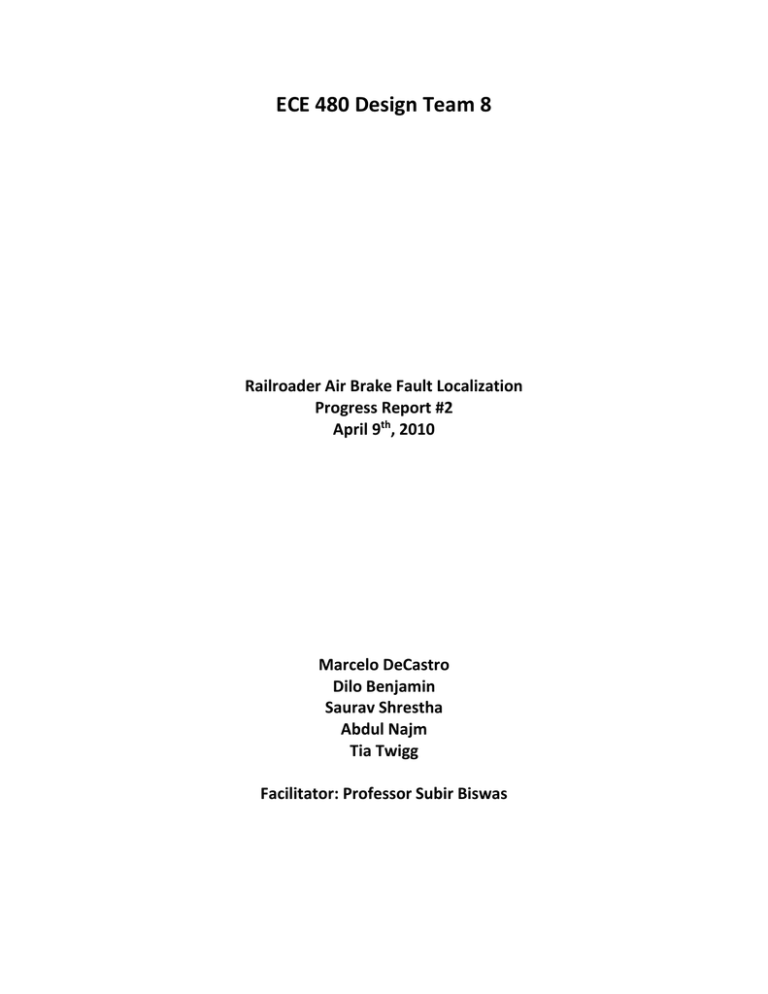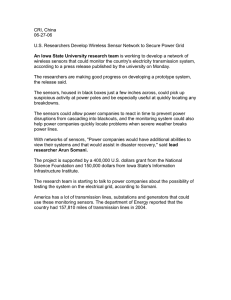ECE 480 Design Team 8
advertisement

ECE 480 Design Team 8 Railroader Air Brake Fault Localization Progress Report #2 April 9th, 2010 Marcelo DeCastro Dilo Benjamin Saurav Shrestha Abdul Najm Tia Twigg Facilitator: Professor Subir Biswas Progress Summary Since the submission of Progress Report 1, Team 8 has made significant progress. This includes purchasing two additional pressure sensors to demonstrate that the receiver can handle multiple signals without any interference. We also traveled to Triple Crown Services to update the sponsor of the progress as well as pick up additional parts. While there, we found out that the glad hand adapter we created is not the proper size to be fitted into the air brake line; thus, we picked up hoses and glad hands of the required size as well. Currently, each team is working on a specific technical role assigned to them independently yet cooperatively to complete our project in the best way possible. Project Progress Backend processing The goal of backend testing is to compare the incoming data against a set standard baseline to see if the values are within the acceptable range. Should the values be outside the range, a message will display, indicating the receipt of an abnormal value. To establish the baseline, we will collaborate with our sponsor and test what an ideal value range would be for a given temperature. We are currently working on creating a simple backend processing comparison in LabVIEW. With no Computer Engineering majors in our group, this has been a challenging, but educational, learn-as-you-go experience. Simultaneously, we will also develop an application in Microsoft Excel that will perform similar backend processing. 2 Hardware Glad hand adaptor The design of the connections on the glad hands for our sensors remains the same at this point, and, most likely, will be our final design. Our current design is a simple and efficient way to connect our sensors into the air pressure break system of the RoadRailers, and works the way we have expected. By simply drilling a hole in the glad hand itself and threading it, we can connect our sensors to the outside of the hose with a metal band and connect to sensor to the pressure inside through the threaded hole. The threads we have used are specially designed to withstand high pressure. Base Station/Networking There have not been any more problems with the base station since the last problem we encountered. However, there has been a misunderstanding regarding the hopping feature on the PressureSensorOne. At this point we know it is an effective device. However, one of the primary reasons we purchased the device was the fact that the sensors are able to hop. This would ensure that the signal from the last sensor on the train, far out of the base station range, would be able to reach the base station without difficulty. We have received conflicting information regarding the sensors’ transmitters’ ability act as repeaters. Our team was told at the time of purchase that the PressureOneSensors 3 would be able to hop, or relay data, from other sensors. Unfortunately, one of the members has recently spoken with one of Electrochem’s representatives and was informed otherwise. However, our team has tested the sensors for the hopping feature and it looks like the sensors do communicate with each other and are able to hop. This test was done before the phone conversation took place. Another test will be performed on April 13th at Triple Crown Services train yard. That way our team will be one hundred percent certain that the feature is available. In case the sensors are not able to do communicate with each other, we already have a solution in mind. An antenna is available which can receive and relay signals. This will enable all sensors’ signals to ultimately reach the base station. Demo Our project is slightly different than other projects in the sense that, due to noise and spatial constraints, we cannot demonstrate all of the applications. The air compressor generates far too much noise for a practical demonstration in a crowded room. Likewise, our sensors have a long range, up to 1.5 km. This makes demonstration of the hopping, or the actual range, problematic. Our solution will consist of filming all of the tests and making a brief movie to show the different applications and scenarios. Our demo is a smaller scale model of what actually takes place on the Triple Crown trailers, without the freight cars. We will use an air compressor to generate a pressure of 70 to 90 psi within the prototype hoses. During this time, the pressure sensors will be 4 turned on and the data recorded. Next, we will install a defective part to simulate a leakage within our system. This test will be the most important in that our system was designed to detect such leakage. The data will be recorded and then analyzed to determine the pressure fluctuations and any deviations that are apparent from the normal curvature. In short, the demonstration consists of long chain of glad hands that will represent the actual system. During the presentation, we will have a prototype available for the audience to visualize the physical dimensions and connections. Also, we will run the software to produce an output of the normal air pressure in the room. The point is to show the accuracy of the sensors and how the pressure is read and measured. Lastly, we will have a wireless range/ hopping demo, which will be done removing the antenna from the transmitter. This limits the range. Then we will be able to hop the signal from one transmitter to the other. This feature is currently under development and we hope to be able to demonstrate it during the final presentation. 5






